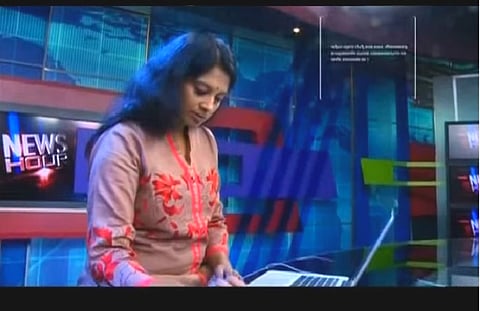

There may be more to it in the case of Malayalam television personality Sindhu Sooryakumar, who has received death threats from cyber gangs after she anchored a channel discussion on the Mahishasura-Durga controversy, than meets the eye.
When private satellite television made its appearance two decades ago, women journalists were a rarity in Kerala, where women outnumber men. The state had already achieved total literacy and girl students had started forging ahead of boys in institutions of higher education. But newspapers avoided employing women saying they could not be put in night shifts.
Television changed the scenario. When the first channel took in a few women, there was subtle resistance from senior male colleagues with print media background. They felt that the presence of women was a restraint on them. The earliest women recruits faded out but those who came in later persevered and went on to claim a place for themselves. Today they are a significant presence in the field and in the studios.
Sindhu Sooryakumar, who is chief coordinating editor of Asianet News, is one of the boldest faces to have emerged in the process. She takes turns with male colleagues in presenting prime time bulletins and anchoring acrimonious debates. She also produces and presents a hard-hitting weekly political programme, Cover Story, which does not spare politicians of any hue.
Physical attacks on journalists are not unknown in Kerala but a death threat is quite unusual. In fact, even political parties with a history of internecine killings are not known to deliver advance warnings to those on their hit list.
After anchoring the February 26 discussion, Sindhu Sooryakumar started getting abusive and threatening calls from the growing tribe of Internet Hindus. When the inflow of unwelcome messages did not stop, she lodged a complaint with the cyber police.
The malicious attack on the journalist followed a pattern that is becoming all too familiar. It started with the circulation of a message through WhatsApp attributing to her, certain words she had not used. It mentioned her telephone number and asked people to call her and protest.
The words attributed to Sindhu Sooryakumar in the message were actually spoken by V.V. Rajesh, who was representing the Bharatiya Janata Party in the channel debate. He was reading out from a pamphlet issued by a group which hails Mahishasura as a hero who resisted subjugation of his people.
Some years ago, a BJP member had complained in the Lok Sabhha that a school textbook contained a lesson which said Durga had consumed liquor during her fight with Mahishasura. The government’s response came from minister Pranab Mukherjee, an ardent devotee who personally leads Durga puja in his village home. He said popular works extolling Durga had references to the goddess drinking liquor.
V. V. Rajesh could have mollified the Hindutva elements by clarifying that the references they were objecting to were made by him and not by Sindhu Sooryakumar. When she suggested this to him, he was evasive saying he needed state party president Kummanam Rajasekharan’s permission to do so.
After Sindhu Sooryakumar complained to the police and the BJP came under criticism from political opponents, Rajasekharan said the party was not involved in the issue. He did not deplore the attack on her.
Within 24 hours, the police picked up a few persons, all associated with Hindutva groups, from different parts of the state. When television cameramen tried to take their pictures, RSS-BJP men blocked them. The organizations did not disown them.
Malayalam channels have a large viewership among Keralites scattered across the world who usually carry with them their local political affinities and sectarian loyalties. It is not, therefore, surprising that the journalist received abusive calls from abroad too.
The government invested the police investigation with added importance by putting Manoj Abraham, an officer of the rank of Inspector-General, in charge of it.
Over the past two decades, there have been many cases of assaults on reporters and camera crew by political, religious and caste groups annoyed with channel reports. In one instance, priests looked on as the faithful attacked a woman journalist who was gathering material for a story which the church authorities did not approve of. Two serving police officers in civilian clothes were part of a crowd that attacked journalists in another church.
So far there has not been a single case of prosecution of persons involved in assaults on journalists. In the matter of cyber cases, the police have a slightly better record. It nabbed a young prankster once who had sent a bomb threat to the President. On another occasion, a young man working in a Gulf country was brought back to India to answer charges of defaming a CPI-M leader by circulating on the Internet the photograph of a mansion falsely claiming it was his house.
It may be trivialising the issue to conclude that the campaign against Sindhu Sooryakumar is just another attempt to intimidate a mediaperson or institution. Given the feudalistic, paternalistic and misogynistic tendencies prevalent in Kerala society, the targeting of a successful woman journalist cannot be dismissed as a mere media issue. Bamboo-wielding Hindutva goons were among those who turned up to take on participants at some recent events like the ‘Kiss of Love’ protest at Kochi.
Whether ít is a media issue or a gender issue, the present case is one with implications for the future. It raises at once questions of media freedom and gender parity.
It is not necessary for the police to track down all the 2,000 odd people who called and abused Sindhu Sooryakumar in order to render justice. It is enough to zero in on a few mischief-makers and make an example of them. But even that may seem a tall order.
Disclaimer: The opinions expressed in this article are the personal opinions of the author.